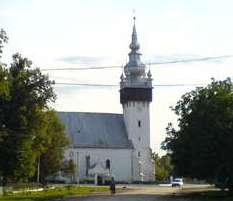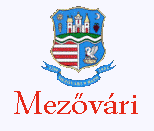

Az alábbi oldalakon Mezővári látnivalóiba és programjaiba szeretnénk betekintést nyújtani!
Bízunk benne, hogy kínálatunk felkelti érdéklődését és örömmel tesz látogatást nálunk, MEZÕVÁRIBAN!
Aktuális
2009.08.30
Játék Határok Nélkül - Sportnap (Mezővári)Bővebben itt...
For english click here!
A Borzsa és a Tisza összefolyásának szögletében szabálytalan alaprajzú földtöltés magaslik a valaha vízfolyásokkal és holtágakkal szabdalt mező fölé. Ennyi maradt mára az Anonymus által is említett Borsova várából, mely a magyar államszervezés korai szakaszában egyházi és közigazgatási központja volt a róla elnevezett Borsova vármegyének.
A vár körül, a Borzsa folyó két partján szorgalmas, otthonteremtő emberek telepedtek meg, s a falut Várinak nevezték el. Az 1241-ben betörő, s útjában mindent elpusztító mongol-tatár hadak elfoglalták és lerombolták ugyan az alig védhető földvárat, de második honalapító királyunk, IV. Béla hívására szász kézművesek és építőmesterek jöttek, s munkájuk eredményeképpen újjáépülő és felvirágzó település csakhamar oppidiummá, mezővárossá emelkedett. Polgárait Erzsébet királyné 1354-ben jelentős királyi szabadalmakkal jutalmazta, s bizonyos, hogy lokálpatriotizmusuk itt, e történelmi romok tövében vert máig eleven gyökeret. Írott források tanúskodnak róla, hogy az egykori várkápolna, valamint a napkelet felől emelt kőtorony sokáig dacolt még az enyészettel, míg 1657-ben a II: Rákóczi György balszerencsés lengyelországi hadjáratát megbosszuló lengyelek végképp le nem rombolták. A gyászos esemény fölött a névtelenségben maradt históriás énekszerző ekképp kesereg:
Beregszász és bereg, Vári és Németi
Édes hazájának csak helyét nézheti?
Nem tudjuk bizonyosan, de lehetséges, hogy településünk sokat próbált népe ettől kezdve használta köztemetőként a szétdúlt várdombot, s az ott keletkezett kőhalomból ekkor kezdte konokul rakni a család és a közösség megmaradásának fészkeit: a házat, a templomot és az iskolát.
A Beregszász felől, Borzsován át közeledő látogatónak már messziről szemébe szökik a református templom négy fiatornyos masszív kőtornya, mely támpillérei, kőkeretes ablakrései által hangsúlyozottan viseli magán a középkori építészet stílusjegyeit. Bádoggal fedett toronysisakja azonban már barokkos ízlésről, az 1795-ös nagy átépítésről tanúskodik, akárcsak szószékének és karzatainak míves, gazdagon díszített faragványai.
Keresztény hívei viszonylag korán, 1595-ben átálltak a helvét eredetű vallástételek követésére, s bőséges adakozókedvük a templom mellett az iskolára is kiterjedt. A prédikátorok, az egymást három évenként követő ?oskolaigazgatók? és ?tógás? deákok a hit, a művelődés és a szellem bástyáit erősítve a közgondolkodás fejlődésére, a gazdaságra is ösztönző hatással voltak. A mezőváros népe időről-időre meg tudta erősíteni kiváltságait, s ezzel nemcsak megtartotta, de folyton bővítette és hangsúlyozta a kisrégióban játszott központi szerepét. A települést átszelő Borzsa folyóra telepített malmok, az erdőségek fája, az országos vásártartási kiváltságok egyaránt vonzották a földművest, a kézművest, a kereskedőt, a begyűjtött adó- és vámtételek pedig szépen gyarapították a város és a munkácsi uradalom javait.
A kollektív emlékezet őrzi a tájhoz is kötődő nagyjaink nevét. Esze Tamást ? aki 1703. május 21-én a rebellis helyi lakosokkal bontotta ki a Nagyságos Fejedelem zászlaját ? és II. Rákóczi Ferencet, a díszpolgárrá fogadott Kossuth Lajost, a szabadságharcok szolgálatában vérükkel áldozó névtelen őseinket örök időkre szívünkbe zártuk, mint ahogyan a két világháború áldozatait, s azt a 191 ártatlan magyart, akiket a sztálini önkény terített le.
Mostoha a múltunk? A természet nemkülönben. Pusztító áradások és perzselő aszályok váltakozásában élünk, ahogy lehet, s várjuk a jobb időket?
The present name of the village is the derivative of the Hungarian noun ?castle? with the affix- I. In 1320 ? the place first being called Vari. At the junction corner of the rivers Borzsa and Tisza , rises above the field slashed with rills and blinds, an asymmetrical ground-planned dam. That?s all remained for today from the Castle of Borsova , which was mentioned by Anonymous too. This castle in the early stage of the Hungarian state organization was the ecclesiastical and administrative centre of the county of Borsova named after the castle.
Round the castle, on both bank of the river Borzsa settled down hard-working and home setting people and called the village ? Vari. In 1241 there were the Mongol Tatar invasion, and the ruinous forces sieged and damaged the barely defended earthwork, but our second founder of the state, King Belas IV invitation, Saxon craftsmen and master builders came. Thanks for their work the rebuilt and prospered settlement became an oppidium or market-town.
In 1354 Queen Elizabeth rewarded with high patents its inhabitants and it?s sure, that their local patriotism rooted here among the historical ruins.
Written sources are wittness about, that the former chapel of the castle and the stone tower, which was built from the Orient, remained to 1657, when the poles answered to Gy. Rakoczi's II misfortune campaign, laid it in ruins finally and totally. We don?t know exactly, but probably the people here began to use this place as a cemetery from this time, and from the remained stones families and the whole community began to build their houses, the school and the church.
Coming from Beregszasz, through the village Borzsova a visitor easily catch sight of the Calvinist Church ?s stone tower, which buttresses and stone windows are wearing the stylistic marks of the medieval architecture.
The spire? covered by sheet metal? is reveal about Baroque style and about the reconstruction of the building in 1795, just like the highly decorated carvings of the pulpit and the choir.
Its Christian followers converted to the Calvinist religion comparatively early in 1595, and their abundant generosity extended over the school too. Preachers, headmasters and students developed the public thinking and agriculture by strengthening the battlements of belief, culture and mentality. The population of the county could hold their privileges from time to time and so they could emphasize their central importance in the small region. The mills settled on the river Borzsa, the trees of the forest, the countrywide market-place attracted the agriculture worker, the craftsman; the trader; the collected taxes and the customs tariff expanded the possessions of the town and the estate of Munkacs.
The collective memory guarding our historical persons names like Tamas Esze, Ferenc Rakoczi II, Lajos Kossuth? they were members of wars of independence. Those 191 innocent Hungarian men, who were the sacrifices of the despotism of Stalin, are also engraved on our memory.
During the flood in 1998 in one part of the village called Palaj 310 house were destroyed in the 2-2.5 meter high water. At that time 286 house were rebuilt. But in the spring of 2001 the second flood (the water was higher than during the first flood (+90cm)) damaged 34 houses again.
In Mezovari people dealed with the rural tourism since 1995. At present 20 families home with half-board are ready for guests, there are spacious double bedrooms with full comfort.
Our ladies of the house run a typical Hungarian kitchen with various types of foods and tastes, but beside the Hungarian meals they favoure the visitors with some Russian and Ukrainian speciality, like Ukrainian borscht, Siberian jam pockets with meat, herring salad, fried salty fish, etc.
The guests can get knowledge about our county?s historical and natural places of interest.
Offers:
- excursion to the ancient earthwork
- ramble in the forest and in the river valley
- meet with the agricultural production
- open-beach at the bank of the rivers Borzsa and Tisza
- for the bravers illicit camping
- cultural programmes
- Sunday Reformed Service
Offers outside the county: the neighbouring settlement's places of interest, among others speleology in Bene.
For a trip you may go on foot, by bike, by horse carriage, but to the further places of Transcarpathia you can go by bus. We provide these things for you.
Turányi Krisztina
Tel: 06-20-5734072
0038052217706
E-mail: lily5@kmtf.uz.ua
evafilep@citromail.hu
Figyelem! A honlap tartalma és az összes fotó szerzői jogvédelem alatt áll! Bármilyen jellegű felhasználás csak személyes engedélyemmel lehetséges! Kivételt képez az "Ajánlás", menüpontok tartalma.
[ A lap tetejére ]


